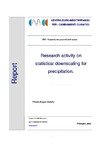This study is a result of the activity carried out at ISC CMCC Division CIRA. The activity
was dedicated on understanding the different modalities used to manage the discrepancy
between the coarse scale at which the COSMO LM1 delivers output and the scale that is
required for most impact studies.
This study reviews 8 methods of interpolation to be used on digital model output data from the COSMO LM. The model output data are predicted precipitation on a regular grid
shaped surface with 305 point location and a resolution of 2,8 Km. Most of the
geographical spatial analysis require a continuous data set and this study is designed to
create that surface. This study identifies the best spatial interpolation method to use for the creation of continuous data for predicted precipitation. ArcGIS was employed as the
software for this study. The following interpolated methods were developed in ArcGis:
Inverse Distance Weight, Radial Basis Function (RBF), Kriging (Ordinary, Simple,
Universal and Disjunctive), Local Polynomial interpolation and Global Polynomial
Interpolation. A statistical measurement of the resultant continuous surfaces indicates that there is little difference between the estimating ability of the 8 interpolation methods with RBFs performing better overall.
NEW NUMBERING (new series “Research papers”): RP0057
OLD NUMBERING (previous series “Technical reports”): TR37
CMCC Divisions


